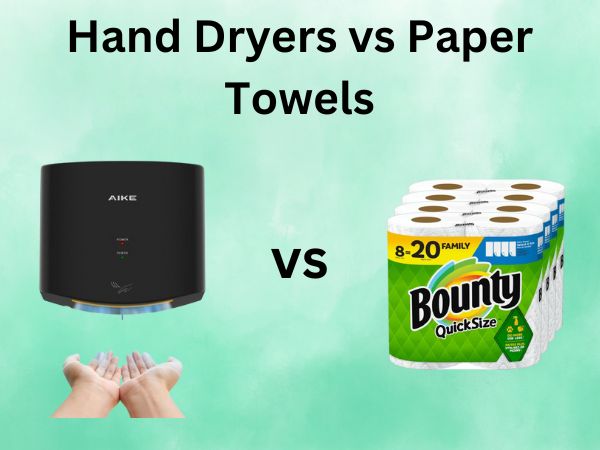Hand Dryers vs Paper Towels [Which Is the Better Choice for Your Restroom?]
Have you ever stood dripping in a public restroom, contemplating whether to reach for those paper towels or position your hands under the electric dryer? It’s a seemingly simple decision that actually connects to much larger issues of public health, environmental impact, and business economics. I’ve been fascinated by this everyday dilemma, and after diving deep into the research, I’m ready to share what I’ve discovered about the great hand-drying debate.
Table of Contents
Understanding the Hand Drying Debate
A Brief History of Hand Drying Methods
Before we judge our modern options, let’s take a quick trip back in time. Paper towels first appeared in restrooms in the early 1900s, while the earliest electric hand dryers showed up in the late 1940s. The technology hasn’t stood still – both options have evolved significantly over the decades.
Remember those first-generation hand dryers that seemed to take forever? Today’s high-speed models can dry your hands in as little as 10-15 seconds. Similarly, paper towels have evolved from rough, single-ply options to softer, more absorbent versions made from recycled materials.
Why Hand Drying Matters in Public Health
Here’s something you might not realize: the way you dry your hands could be just as important as washing them in the first place. Proper hand drying removes remaining moisture where bacteria thrive, completing the handwashing process. Wet hands can transfer bacteria more easily than dry hands – up to 1,000 times more, according to some studies.
This isn’t just about personal hygiene. In hospitals, offices, schools, and restaurants, hand drying methods can influence community health outcomes. It’s a public health consideration that deserves our attention.
Environmental Impact Comparison
Carbon Footprint Analysis
When comparing environmental impacts, we need to look at the entire lifecycle of each option.
Manufacturing Process Comparison
Paper towels require trees, water, and chemicals for production. Even recycled options consume resources. The manufacturing process involves harvesting raw materials, pulping, bleaching, and processing – all energy-intensive steps that generate greenhouse gases.
Hand dryers require plastic, metal components, and electronic parts. Their production involves mining materials, manufacturing electronic components, and assembly. While this process creates pollution, a single dryer serves thousands of uses over its lifetime, spreading out its manufacturing impact.
Energy Consumption Metrics
This is where things get interesting. Traditional hand dryers use about 2,200 watts of power per use, while newer models like high-speed, energy-efficient versions use between 700-1,400 watts. The average drying cycle ranges from 10-45 seconds depending on the model.
Paper towels don’t require electricity at the point of use, but their environmental footprint includes energy used during manufacturing, transportation, and disposal processes. When you factor in these hidden energy costs, the comparison becomes more complex.
Waste Generation and Management
Paper Towel Disposal Challenges
The numbers here are staggering. The average person uses 2-3 paper towels per handwashing. For a busy facility with 200 daily visitors, that’s potentially 146,000 paper towels annually heading to landfills.
While paper towels are biodegradable, they rarely break down properly in landfills due to compaction and lack of oxygen. Many paper towels also can’t be recycled once they’ve been used because they’re contaminated with organic matter (and frankly, who’s separating their bathroom paper waste?).
End-of-Life Considerations for Hand Dryers
Hand dryers eventually reach the end of their useful life too. The average commercial hand dryer lasts 7-10 years, after which its components become electronic waste. E-waste contains potentially harmful materials if not properly recycled.
However, one hand dryer can prevent tons of paper towel waste during its lifetime. A busy restroom might save 1-2 tons of paper waste annually by switching to hand dryers.
Cost Analysis
Initial Investment Costs
Let’s talk numbers. Basic hand dryers cost between $100-$400, while high-speed, energy-efficient models range from $400-$1,200+. That’s certainly more than a paper towel dispenser, which typically costs $25-$150.
The upfront cost difference is substantial, but it’s only the beginning of the financial story.
Long-term Operational Expenses
Paper towels create ongoing costs that add up dramatically over time. A busy restroom might use $1,000-$2,000 worth of paper towels annually, plus labor costs for restocking and waste management.
Hand dryers, meanwhile, cost about $0.10-$0.40 in electricity per 1,000 uses. Their annual operational costs typically range from $50-$200 depending on usage patterns and local electricity rates.
Maintenance Requirements
Paper towel dispensers need regular refilling, which requires staff time. Dispensers can jam or break, requiring replacement every few years.
Hand dryers need occasional cleaning and might require part replacement after years of service. Most quality models come with 5-year warranties, suggesting their expected minimum lifespan.
Replacement Schedules
In high-traffic environments, paper towel dispensers might need replacement every 3-5 years due to wear and tear. Hand dryers typically last 7-10 years or longer with proper maintenance.
When all costs are calculated across a 5-year period, hand dryers often present significant savings despite their higher initial price tag. The break-even point typically occurs within 6-18 months of installation for most facilities.
Hygiene and Health Considerations
Scientific Studies on Bacterial Spread
This is perhaps the most controversial aspect of the debate. Some studies suggest paper towels remove more bacteria during the drying process through friction. A much-cited Mayo Clinic study found paper towels can reduce bacteria on hands by up to 77%.
Other research indicates modern high-speed hand dryers, particularly those with HEPA filters, effectively remove bacteria from hands without spreading microorganisms through the air.
Cross-Contamination Concerns
The touch points in restrooms present cross-contamination risks. With paper towels, users must touch the dispenser and possibly the waste bin.
Touch vs. Touchless Options
Both hand drying methods now offer touchless options – automatic paper towel dispensers and sensor-activated hand dryers. These reduce contact points but come with higher price tags.
Modern hand dryers with HEPA filtration systems capture 99.97% of bacteria from the air they expel. This technology addresses earlier concerns about traditional dryers potentially circulating bathroom air.
Drying Efficiency and Thoroughness
Drying efficiency matters for both hygiene and user satisfaction. Paper towels typically dry hands in 10 seconds or less. Traditional warm air dryers take 30-45 seconds for complete drying, while high-velocity dryers achieve dryness in 10-15 seconds.
The thoroughness of drying affects bacterial transfer. Inadequately dried hands (which often happens when people get impatient with slower dryers) can transfer bacteria more readily to surfaces touched afterward.
User Experience Factors
Speed and Convenience
Time matters in busy restrooms. Paper towels offer immediate access and quick drying. Traditional hand dryers require patience, while newer high-speed models significantly reduce waiting time.
Beyond drying hands, paper towels serve multiple secondary purposes – wiping surfaces, opening doors, or blotting makeup – that hand dryers cannot replicate.
Noise Pollution Considerations
The whooshing sound of high-speed hand dryers can reach 80-90 decibels – equivalent to a food blender or motorcycle. This noise level can be uncomfortable for some users and problematic in certain environments like libraries, hospitals, or offices where quiet is valued.
Paper towels offer silent operation, making them preferable in noise-sensitive environments.
Accessibility Challenges
Hand dryers mounted at standard heights may be inaccessible to wheelchair users or children. The noise and sensation of powerful air dryers can also distress some individuals with sensory processing disorders or certain conditions including autism.
Paper towel dispensers, when properly installed at accessible heights, accommodate more diverse users, though they require manual dexterity that some individuals with mobility impairments might find challenging.
Making the Right Choice for Your Space
Facility Size and Traffic Considerations
High-traffic facilities like airports or stadiums might find hand dryers more economical and easier to maintain than constantly restocking paper towels. A busy airport restroom might see thousands of users daily – imagine the paper waste and maintenance demands!
Smaller facilities with lower traffic might find paper towels perfectly adequate, especially if waste disposal and restocking logistics aren’t overly burdensome.
Hybrid Approaches
Many facilities now implement hybrid solutions – offering both options to accommodate different preferences and needs. This approach recognizes that no single solution works perfectly for everyone.
Some innovative facilities are installing hand dryers above sinks to eliminate water dripping on floors, or positioning paper towel dispensers by exits for those who prefer to use towels to open doors.
FAQs
1. Do hand dryers really spread more bacteria than paper towels?
Earlier studies suggested this, but newer research shows modern hand dryers equipped with HEPA filters actually reduce bacterial spread. The key factor is using updated technology – older models without filtration systems may indeed circulate bathroom air more than desired.
2. How much money can a facility save by switching from paper towels to hand dryers?
A medium-sized facility with approximately 200 daily visitors could save $1,000-$2,000 annually on supply costs alone. When factoring in reduced labor for restocking and waste management, the savings typically enable ROI within 6-18 months after installation.
3. What’s the most environmentally friendly hand drying option?
High-efficiency hand dryers typically have the lowest lifetime environmental impact when considering manufacturing, usage, and disposal phases. However, paper towels made from 100% recycled post-consumer waste and composted after use can also be relatively eco-friendly compared to standard options.
4. Are there situations where one option is clearly better than the other?
Yes – healthcare settings often prefer paper towels for their friction-based bacteria removal, while high-traffic public venues typically benefit from the reduced maintenance and waste management advantages of hand dryers.
5. What innovations are emerging in the hand drying industry?
The latest developments include ultra-energy-efficient dryers using just 300 watts of power, antimicrobial coatings on hand dryer surfaces, biodegradable paper towels that decompose within weeks instead of years, and smart dispensers that track usage patterns to optimize maintenance schedules.
Conclusion
The hand dryer versus paper towel debate doesn’t have a one-size-fits-all answer. The “right” choice depends on your specific priorities – environmental impact, budget constraints, hygiene concerns, or user experience preferences.
What’s becoming increasingly clear is that newer technologies are narrowing the gaps between these options. High-efficiency hand dryers with HEPA filtration address many previous hygiene concerns, while sustainably sourced paper towels reduce environmental impact.
As we move forward, the most thoughtful approach might be considering your facility’s unique needs rather than seeking a universal solution. Sometimes, providing both options represents the most inclusive strategy, acknowledging diverse user preferences while balancing environmental and economic considerations.


![5 Best No-Drill Towel Bars [A Complete Guide for Modern Bathrooms]](https://bathroomexplorer.com/wp-content/uploads/2025/02/Best-No-Drill-Towel-Bars.jpg)
![Washcloth vs Hand Towel [The Ultimate Bathroom Textile Comparison]](https://bathroomexplorer.com/wp-content/uploads/2025/02/Washcloth-vs-Hand-Towel.jpg)
![5 Best Bath Towels for Embroidery [In 2025]](https://bathroomexplorer.com/wp-content/uploads/2025/02/Best-Bath-Towels-for-Embroidery.jpg)
![5 Best Dish Towels for Drying [Ultimate Guide for Your Kitchen Needs In 2025]](https://bathroomexplorer.com/wp-content/uploads/2025/02/best-dish-towels-for-drying.jpg)
![Tea Towel vs Kitchen Towel [What’s Really the Difference?]](https://bathroomexplorer.com/wp-content/uploads/2025/02/Tea-Towel-vs-Kitchen-Towel.jpg)
![5 Best Beach Towels for Sand [The Ultimate Guide for 2025]](https://bathroomexplorer.com/wp-content/uploads/2025/02/Best-Beach-Towels-for-Sand.jpg)